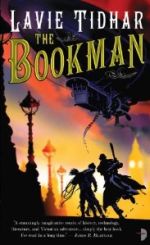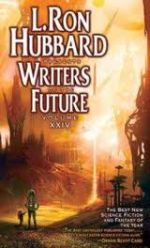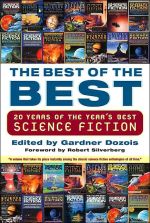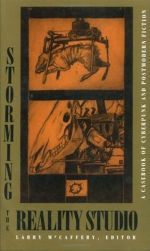Identity Crisis:
Who are we, if we can choose who we are?
I have a confession to make, though in this particular company perhaps it will come across as more of a boast: I’m a huge gaming nerd. Every time a new Massively Multi-Player Online Role-Playing Game (MMORPG) with even a little bit of buzz behind it launches, I buy it. I don’t play long—I rarely make it much past whatever is achievable in about twenty hours of game play with any one character, though I almost always play one character of each “race” through at least the starter towns. I don’t have much interest in killing MOBs or collecting gear, get claustrophobic even in virtual dungeons, and can’t stand the grind and mayhem of raiding, so I never even try to make it to end game. What I love is the chance to try on new, and often here-to-fore unimagined, identities. I can waste as much time playing around with character creation, when the game let’s me fiddle with things like the bridge of my nose or the slope of my eyes, as I will ever put into playing that particular character.
For me, the fun is in stepping outside my embodied self for a little while and pretending to be someone completely other than who I really am. It’s a pleasure that I don’t get from single-player games; performing the identity requires the participation of others who are also performing fictional versions of themselves.
Avatars in virtual environments provide us with the opportunity for social interactions in which our physical representations are fully chosen. Sometimes we have purely fictive choices: Erudite, Blood Elf, Ogre, Raki, Bahmi, Twi’lek, Wookiee. Beings taken either from traditional high fantasy, science fiction, or created for specific game settings but not found anywhere outside the imagination. Sometimes, players are presented with choices based loosely on human identity constructs. Asheron’s Call, one of the first such games, limited players to three “races” based loosely on European, Asian, and Middle Eastern traditions. It wasn’t until the rise of more freeform virtual environments, such as There and Second Life, that users (because it no longer seems appropriate to call the members of these virtual communities “players”) were given the opportunity to create representations of themselves without any backstory beyond our own cultural understanding of the ways in which embodiment signifies identity.
I was an early participant in Second Life. I can recall, for instance, when there were only six “sims” and almost every active user knew every other active user, at least by reputation. When I first logged in, it never occurred to me to represent as anything but white and female. I chose a hippie-esque first name and a Jewish last name, Bhodi Silverman, and created an avatar who looked very much like me—same hair and eye color, fair skinned, with a prominent nose and an approximation of my perpetually unkempt hair—in every way but one. My avatar was painfully skinny. At the time, I was very overweight and this was the one part of my embodied experience that pained me, so I changed it. It was a simple thing, though eventually I came to understand that the ability to choose my physical appearance was actually very profound.
One thing you noticed, if you were on the grid back in those early days, is that there were an awful lot of white people in Second Life. Or, at least, an awful lot of white avatars. On the first MLK Day after the launch of Second Life, we held an in-game discussion about it. Few answers were generated by this event, but lots of questions were raised. What does race mean if one’s visual representation is fully chosen? If the color of one’s skin is as changeable as the color of one’s clothing? What about gender, age, and able-bodiness, all of which are currently signified by visual cues which are, for the most part, beyond our control outside virtual environments?
Vernor Vinge’s Rainbows End is one of the most intriguing books I’ve read in the last year. It explores the possibilities of a world in which we view everything through a digital lens, and as a result are able to overlay our reality with fictive, mediated experiences. In Vinge’s vision of the future, the world is part MMORPG, part Usenet, and part Google Everything. Underneath all of this, though, remain the embodied realities of human existence. His characters, for the most part, don’t enhance their own appearance except when participating in specific activities or when in areas controlled by certain “belief circles”—people who have agreed to share a consensual reality, usually one based on fiction or popular media. Old men can become young again, but through medical intervention, not just visual pretense. A character who is a wheelchair user makes no attempt to appear able-bodied. The potential for radically departing from one’s own “natural” appearance is, in this book, largely the prerogative of intelligence agents and spies. But the potential is there for anybody to elect their appearance, and thus to control the standard identity markers we use, rightly or wrongly, to tell us who somebody is.
Jay Garmon’s excellent story Perfection , which appeared in Issue 11 of Redstone Science Fiction, looks at possibilities of enhancing one’s appearance to maximize one’s attractiveness to a specific person. The protagonist uses complex software to read the responses of a woman he meets in a club and to tailor his appearance based on her nonverbal cues. They both create enhanced versions of themselves as part of the flirting process, and the knowledge that these representations are false has no impact on their ability to generate attraction. But neither changes what we would currently consider basic identity elements. They represent as being the gender, race, and general age which matches their embodied selves. How would the story be different if they had made one or more of these more radical changes as part of the seduction?
For this year’s contest, we are looking for stories that explore what race, gender, age, able-bodiness, size, and other visually represented identities axes will mean in a time when one’s appearance is fully self-selected. Will everyone who works at Billy Bob’s Old Timey Country Restaurant be required to represent as blue-eyed, white-skinned boys and girls just off the farm? Could whiteness become compulsory, at least during a shift at the local Cracker Barrel? Conversely, would urban dance clubs be full of white suburban teenagers wearing off-the-shelf representations of Tupac and MC Lyte, and if so, would this move us toward the much-vaunted “post-racialism” or be a degrading and racist exercise in cultural blackface?
In a world where people already have dramatic and expensive surgeries to become thinner, appear younger, what will happen to age and size? It seems inevitable that it would become culturally unacceptable — particularly for women — to represent as fat, except in a fetishized context. Would showing one’s true body size become a feminist statement, the bra burning of a new era? Would wrinkles and gray hair mark someone as a counterculture radical in the same way that long hair and Grateful Dead t-shirts used to mark some men as hippies or eyeliner and dyed black hair mark others as Goth?
Will it become a point of pride for people with disabilities to maintain a visual representation that acknowledges their different embodiments… and will there be people without disabilities who represent as if they are disabled in order to be part of a community to which they don’t really belong? Or do they? The disability community struggles with the question of whether those with Body Integrity Identity Disorder—people who feel they would be happier living as persons with disabilities, usually through amputation of a limb—are or are not persons with a disability. Will this mutability in representation create communities in which people can match their external appearance to their internal experience, and how would this impact our understanding of authenticity and essentialism? Is this freedom of expression or a cooptation of experience?
What do age and gender mean if a six year old girl and a ninety year old man can both represent as the same twenty year old female just by buying an off-the-shelf avatar package? Will the idea of “race” mean the same thing when one can be black, white, elvish, or orcish at will? What is “identity” in a world where everyone has the potential to be a shape-shifter?
A few hints before you begin writing. It’s unlikely that a story about a sexual predator who uses this ability to infiltrate gatherings of children would win the contest. We’re looking for greater depth and imagination than that tired trope. It’s also unlikely that a piece which consists primarily of characters discussing the ethics of enhanced representation would win. Show us, don’t tell us, the impact of these technologies. Finally, remember that the story is the most important thing. Give us characters we can care about and a plot that pulls us through the prose. Give us good writing and new ideas. Make us either wish we could live in your future or glad that we don’t. Ultimately, this is a fiction contest, and the entries will be judged for their value as stories, and not for the political or social views taken up by the author.
I’m excited and happy to be judging the second Redstone Science Fiction contest, and can’t wait to read your entries. I hope you are as inspired by this year’s theme as I am.
Sarah
Sarah Einstein is a Puschart Prize winning author whose work has appeared in PANK, Fringe, Ninth Letter, Whitefish Review, and other literary journals. She is pursuing a Ph.D. in Creative Writing at Ohio University.
Enter Michael Ray.
Here’s the plan:
1) The identity-themed story contest will open June 15 and remain open until August 15.
2) 4000 words max, 5 cents per word, and follow our Guidelines.
3) Submit to identitycrisis@redstonesciencefiction.com.
4) Sarah & our editors will choose the best submission and the story will be scheduled for publication on September 1st.
























16 comments
[…] and Contest Prompt Identity Crisis: Who are we, if we can choose who we are? by Sarah […]
[…] What will identity mean in a future where it is completely mutable? She examines this question in Identity Crisis: Who are we, if we can choose who we are? and brings us a new contest for this summer. Read her essay and send us a work that addresses the […]
To me this seems more like a call for submissions than a contest.
[…] I admire his writing. He was contacting me in response to my having posted the contest call and essay for the annual contest at Redstone Science Fiction, for which I am the judge. His concern was […]
“For this year’s contest, we are looking for stories that explore what race, gender, age, able-bodiness, size, and other visually represented identities axes will mean in a time when one’s appearance is fully self-selected. ”
I found the “visually” to be a tad limiting. I mean, it’s only one sense.
But I love the essay. Maybe it should win.
Christopher,
You can TOTALLY include other senses! You’re right, it is unnecessarily limiting–and ableist. I should know better. Go for it!
I have a question. I recently submitted a story to Redstone (before finding out about this awesome contest prompt). Can I submit something to the contest even though I haven’t heard back about the story yet? (It was submitted mid-May, so I’m not sure if i’ll hear about it before the contest ends or not!)
Please let me know and thanks for another thought-provoking essay/contest!
Noor,
I just saw this, and I’m not an official Redstone Editor, but I would say, “Of course you can!” If I’m wrong, blame me, and I’ll talk the actual editors into allowing your submission. But I see nothing in our rules that suggests you couldn’t, and I can’t wait to see what you’ve written!
Sarah
Indeed, Noor, that would be great.
Hi Sarah and eds.,
For this contest, do we have to consider identity only as individual identity, or are we free to play with the idea of constructed cultural identity as well? (That is, the identity of an entire culture.)
Interpret broadly and write boldly! (In other words, if it works for you, write it and we’ll see if it works for us, too! But I like the sound of it.)
Sounds good to me. Broad interpretations are always my favourite. ;)
I’ll have to watch out for the closing of the submission period next time; I didn’t know if it was PST or EST, so I hope my submission was accepted but if not, that’s my fault for not submitting sooner.
Do we know when the announcement will be made? It’s said a “few days” for about two weeks. :)
Having a hard time choosing, will be done this weekend.
:) Thanks!